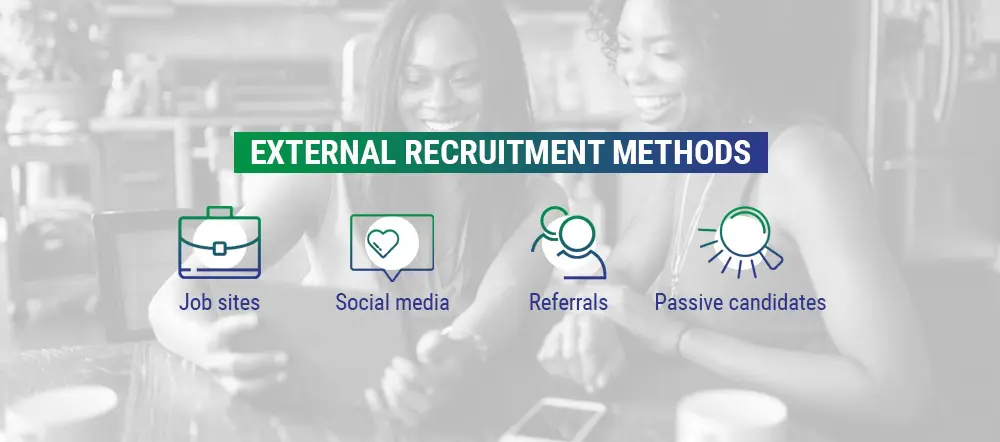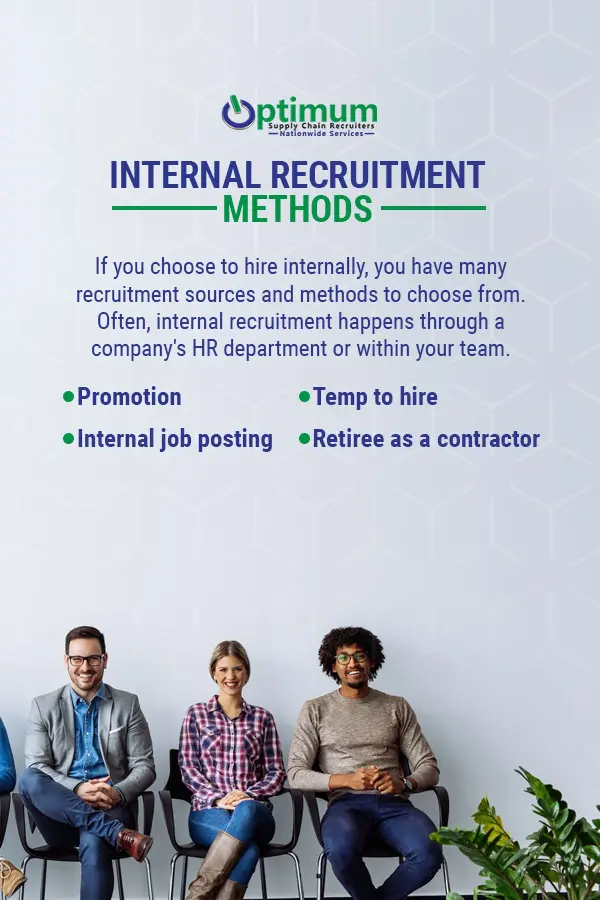
Table of Contents
- External Recruitment Definition
- Pros of External Recruitment
- Cons of External Recruitment
- External Recruitment Methods
- Internal Recruitment Definition
- Pros of Internal Recruitment
- Cons of Internal Recruitment
- Internal Recruitment Methods
When a position opens up in your company or a new role gets created, you have to decide how to fill it. As a hiring manager, you might be wondering what is the best recruiting method is it better to recruit internally or externally. Recruitment becomes even more complicated when it comes to specialized job roles. In this guide, we’ll differentiate between internal and external recruitment and help you weigh the pros and cons of each.
What is External Recruitment?
An external candidate is an outside hire or a candidate who does not currently work for the organization recruiting. During an external recruitment search process, the search committee finds new quality candidates by advertising positions to the public or using the skills of a recruiter. Through outside recruitment agencies, a company can invigorate their organization with fresh talent.
Hire Top Talent Call Us: 800-300-7609
What are the benefits of External Recruitment?
What is the advantage of external recruitment? External recruitment leads to a host of benefits. First, a company can find talent already well-versed in the necessary skills, saving time on training. A new leader or team member can reinvigorate a company culture, bringing new problem-solving abilities and ideas to the floor. It’s a fantastic way to kick off big changes, a restructuring or a new strategic direction. You’ll have more candidates to choose from, so you can be more confident in your choice. Hiring an external candidate is a great option because:
- They can offer more technical skills: Technology and best practices are always evolving, and your current talent pool might be behind the curve. Those who have been with your company for many years might not be up-to-date on the skills necessary to stay competitive. By hiring based on candidate experience, you will work with someone on the cutting edge who can bring new technical expertise to the table.
- They have specialized talent: A top sales rep doesn’t necessarily have the abilities and personality to be a fantastic sales team manager. Often, hiring for an important role requires finding a unique skill set and perspective. Your team might be excellent at the things they do now but haven’t specialized in what you need. For a company that’s introducing a new structure or bringing a position in-house for the first time, you want someone with years of experience to steer you on the right track.
- They encourage cognitive diversity: Any team profits from differences in perspective. These variations are known as “cognitive diversity.” Studies show that teams with higher levels of cognitive diversity solve problems at a faster rate. A new perspective injects your team with new ideas and creativity.
- They can bring about positive change: If your team has grown complacent in the way things have always been done, it might be time for a change in leadership. A new face in an important role can drive innovation, process improvements and revive your corporate culture.
- You get to choose from a larger candidate pool: When you hire externally, anyone can step up to the plate. The average corporate job posting receives 118 resumes. With such a large candidate pool, you’ll be able to find the candidate most suited for the job, with several star performers rising to the top.
Disadvantages of External Recruitment
One main drawback of an external recruiting firm is that new talent takes some adjustment. First, the hiring team has to get to know the candidate. Then, the new hire has to get to know the job while the rest of the team gets used to the new coworker. These steps take some time, but the right candidate will shine through after some time. Some of the other disadvantages of an external recruiting process are:
- The new candidate will have a learning curve: With any new hire, you can expect a growing period. On average, an internal candidate will outperform an external candidate at first. Within their first three months, an external candidate will pick up the pace. By their first year in a new role, an external candidate will have a 105 percent revenue achievement, which is in line with their internally-hired counterparts. So, while you can expect a buffer period as a new candidate gets to know your company and their new role, it’s only temporary.
- It costs more to hire externally: External recruitment is a more significant investment than internal recruitment. Since you don’t know the candidates, you must vet and interview them extensively. That said, you can source external candidates that already have the necessary qualifications. So, while you might invest more time and money upfront during the hiring process, you can make up for it with reduced training costs.
- The existing employees may be resistant to change: Some team members might fear a new leader or coworker. Many people like the status quo, so change can be an obstacle to overcome. The right fit can usually calm these anxieties and turn them into a positive.
Learn More About Our Recruiting Services
External Recruitment Methods
There are several strategies your company can use for external recruitment. Working with a recruiter can help streamline the process — they will take care of the initial outreach and ensure only the best resumes land on your desk. Are you wondering what is an example of an external recruitment source? There are several external recruitment sources and methods. You can check out our examples of external recruiting sources below.
- Job sites: One of the most popular ways for a job seeker to find a new position is through a job website also known as a job board. Many companies and recruiters post directly to these sites for a fee. Your company can also post for the job on your company website. Some companies even build specific job portals on their website to house all open positions. Many job sites will pick up your postings automatically and then funnel prospective candidates to your site.
- Social media: Social media platforms offer a variety of ways to get in touch with new candidates. LinkedIn, the professional’s social network, lets you post jobs to your company’s profile. As a career networking site, it’s also a great place for recruiters to reach out to potential candidates. Companies and recruiters can also find luck posting paid advertisements on other social media platforms.
- Referrals: Referrals continue to be an excellent source of new talent. Employers love referrals — 88 percent of them rank references as their number one source for superior talent. Recruiters can also find referrals by asking their network for potential matches or requesting employee referrals. When a recruiter places a candidate with a similar job title, they can ask for recommendations to fill their roster of open positions.
- Passive candidates: Many of the best candidates aren’t looking for a new job. Head hunters tap top performers to custom-build a superstar talent pool. Passive candidates are less likely to have a checkered job history or get swept away by a competing job offer.
Internal Recruiting Definition
There are times when it makes more sense to hire for a position internally. An internal hire saves the hiring team time because of their familiarity with the candidate. The candidate also has experience within the company.
Advantages of Internal Recruitment
Sometimes, it makes more sense to hire for a position internally. An internal hire saves the hiring team time because they are familiar with the candidate. The candidate also has experience within the company. The advantages of internal recruitment include:
- They save the hiring team time: Hiring from within allows hiring managers to skip ahead in the hiring process. They might have a good working relationship with the candidates already — so, it takes far less time to get to know them through the resume screening and candidate interview process. They also often come with a recommendation from their current manager, giving you confidence in their abilities.
- They already fit into the culture: Any candidate that’s been with a company for a long time understands the organization’s values. They know the ins and outs of workplace culture and have the same definition of success as their peers. While an excellent external candidate will also have a sound cultural fit, an internal candidate will have a deeper understanding of your company’s current business environment from the start.
- They are a familiar face: When you hire an internal candidate, you already know them. You’ve seen their work ethic in action. You know how they perform doing similar tasks and where their areas for growth are. When you promote someone from within your organization, you have talent that’s already familiar with the way things work. They know the industry and have worked with the processes at your company.
Disadvantages of Internal Recruitment
When you hire for internal positions, you’re bound to hit some snags along the way. Internal recruitment can put pressure on the entire office — it can also be difficult for the hiring team to find qualified candidates. If you choose to hire internally, you’ll have to avoid upsetting other managers and job candidates. Some possible drawbacks if hiring internally are:
- It may interfere with company policy: Many corporations have rules for internal hiring practices that can limit your options. Up to 25 percent of companies don’t allow managers to approach internal talent directly. Internal candidates might not get encouraged to apply.
- It may disrupt office politics: Office politics play a significant role in internal hiring decisions. Team leaders might recommend unqualified candidates because they have a personal relationship. Hiring managers might feel as though they are poaching a top performer from another team.
- It may fuel jealousy: Coworkers who are up for the same promotion may harm their professional relationships with one another. After a decision passes, the candidates may feel passed over and become disengaged. Some might feel undervalued and seek other opportunities.
- You have a smaller candidate pool: Even in a large corporation, only a few individuals are qualified for most roles. Depending on the position, you might be limited to candidates from one department. You might also find limitations in your cross-department options. A smaller pool is one of the top barriers to internal recruitment.
- You have to fill two positions: When you hire internally, another position in the company becomes vacant. So, besides the time and money it takes to fill an internal position, the company also has to start the hiring process over for another role.
Internal Recruitment Methods
If you choose to hire internally, you have many recruitment sources and methods to choose from. Often, internal recruitment happens through a company’s HR department or within your team. It’s rare to work with a recruiter to source an internal hire. Some possible internal recruitment methods include:
- Promotion: One of the most popular internal recruitment strategies is to promote talent up the ladder. Many candidates are eager to take the next step, prove their capabilities and receive a bump in pay. A promotion might not require internal candidates to apply for their new position. When you promote someone, prepare to give your new hire some training to get them up to speed with their increased responsibility.
- Internal job posting: An internal job posting works pretty similarly to any other job post a company writes. You can post internal positions to your website with a caveat for internal applicants only. You might also post flyers in the break room or send out an announcement via email. Interested parties will apply as they would any other job.
- Temp to hire: You can also choose to hire a temporary employee to test drive their skills. Much like hiring an intern, a temp lets you ensure a good cultural fit before making a permanent decision. If you work with a recruiter to source interim talent, you might have to pay a fee for sourcing the candidate and convert their contract into a permanent one.
- Retiree as a contractor: Another way to hire internally is to bring a retiree back on under a contract. This method works best for a short-term project or part-time position. You get the advantage of an experienced candidate who can afford to take on a smaller commitment than a full-time job.
Is It Better to Recruit Internally or Externally?
Choosing between internal or external recruitment can be a complicated decision. What’s right for one particular role might not work for the next. Your department might require a unique set of skills or have a different hiring budget than other departments. So, you might not be able to operate the way others in your organization treat the recruitment process.
Internal recruitment is a better hiring strategy for some situations, for example:
- When a position requires more company knowledge or a seamless cultural fit.
- When you have lots of talent eager to climb the ladder.
- When you already have the right skills within your company.
External recruitment can be more prudent in many circumstances, like:
- When it’s time to grow your business.
- When you want a jolt of creativity and a fresh new perspective.
- When you need to restructure or lead your team in a new direction.
- When you need to bring new skills and expertise into your organization.
Learn More About Our External Recruiting Company
Partner With Optimum Supply Chain Recruiters for Your External Recruiting
OptimumSCR is a unique recruitment firm with a specialty in the supply chain and logistics discipline. We only recruit for logistics and supply chain professionals, so we understand your needs for these highly-specialized roles. We can help you hire hard-to-fill positions such as managers, vice presidents and other higher-ups.
We don’t use job postings, so we can uncover hidden talents and provide you with a portfolio of professionals that can make your supply chain and logistics management team shine. We’re a nationwide service that can help you with logistics recruiting, contingency recruiting, engagement searches or hiring interim personnel.
Learn more about the industries we serve, our services and reach out to start hiring top talent quickly.




